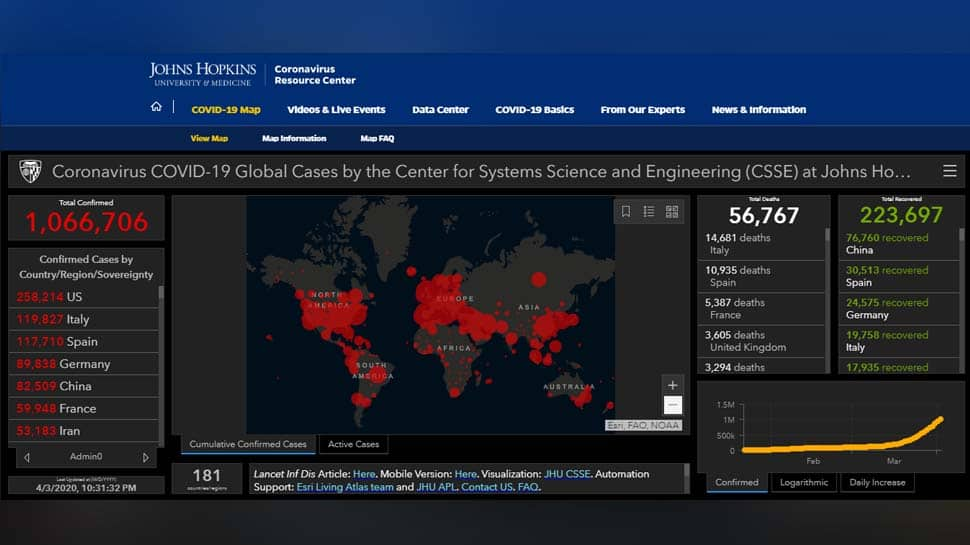Coronavirus COVID-19 death toll 56,767 globally, positive cases over 10.6 lakh
The US remained at the top with the maximum number of positive cases at 258,214, followed by Italy with 119,827 infected cases, Spain with 117,710 cases, Germany with 89,838 cases and China maintains the fifth spot with 82,509 cases.
Trending Photos
)
As people across the world continued to remain under a strict lockdown due to the coronavirus COVID-19 pandemic, the total number of positive cases reached 1,066,706 and the death toll stood at 56,767 at 11.45 pm (IST) on Friday (April 3, 2020). The US remained at the top with the maximum number of positive cases at 258,214, followed by Italy with 119,827 infected cases, Spain with 117,710 cases, Germany with 89,838 cases and China at the fifth spot with 82,509 cases.
The highest death toll so far has been recorded in Italy with 14,681 deaths, followed by Spain with 10,935 deaths, the US with 6,605 deaths, France with 5,398 deaths and the UK with 3,611 deaths. All these countries have surpassed China, the epicentre of the virus, in terms of the death toll.

In Italy, the number of new cases was slightly lower on Friday, growing by 4,585 from a previous 4,668. April 3 was the fifth consecutive day in which the number of new cases remained within a range of 4,050-4,782, confirming government hopes that the epidemic has hit a plateau, ahead of an expected decline in the near future. Italy hit a daily peak of 6,557 new cases on March 21.
The daily death toll has been between 727 and 766 for the last three days, down from 837 on March 31 and a peak of 919 on March 27. Of those originally infected nationwide, some 19,758 had fully recovered on Friday, compared to 18,278 the day before. There were 4,068 people in intensive care, up from a previous 4,053. Italy has registered more deaths than anywhere else in the world and accounts for more than a quarter of all global fatalities from the virus. In Lombardy, the epicentre of the outbreak, the daily death toll was slightly lower than the day before, coming in at 351 against 367 on Thursday, but new infections rose to 1,455 versus 1,292.
In the US, the New York state recorded more than 500 coronavirus-related deaths in a single day, bringing its total to nearly 3,000, or about the same number killed in the United States on September 11, 2001, attacks, said Governor Andrew Cuomo said. New York City has mere days to prepare for the worst of the novel coronavirus onslaught, said Mayor Bill de Blasio, whose city has suffered more than a quarter of US deaths in the outbreak. He pleaded for federal government help to end a shortage of medical staff and ventilators.
The 24-hour death toll was 562, raising the New York state total to 2,935 fatalities, Cuomo said. He called it the "highest single increase in the number of deaths since we started." De Blasio has asked for 1,000 nurses, 150 doctors and 300 respiratory therapists as the number of COVID-19 cases in the city is expected to rise sharply next week. New York City has yet to receive a resupply for the up to 3,000 ventilators needed by next week, de Blasio said, urging President Donald Trump to mobilize medical personnel from the US military.
In New Jersey, Governor Phil Murphy ordered that all flags be lowered to half-staff for as long as the emergency remains in effect to honour those lost to the coronavirus. He said New Jersey, which has more than 29,000 cases, was the first state to take such a measure. New York City and state have both complained that federal resources have not reached them quickly enough, but Cuomo said Trump responded swiftly to a request he made on Thursday that a makeshift hospital at a Manhattan convention centre is allowed to take in patients with the COVID-19 disease. Initially, it was set up to treat all other patients.
A grim picture can be seen in Spain as it struggles desperately to cope with almost 120,000 coronavirus infections. It barely has the strength to help its overwhelmed care homes and their elderly residents, singularly vulnerable to the respiratory disease. With hospitals stretched to breaking point, the elderly are being turned away, and the care homes, lacking staff and appropriate equipment, must do what they can for the sick and dying.
"When they are very sick - not only here, in more than one place - ... when they see there is no solution ... they sedate them and see how long they last because they`re leaving intensive care wards for younger people," said Maria Jose Alvarez, whose 85-year-old mother is in a home near Barcelona.
Of a total of 3,000 deaths recorded at Madrid nursing homes in the past month, regional leader Isabel Diaz Ayuso said around 2,000 were likely to have been the result of coronavirus, though it was unclear how many of those appear in official figures due to a lack of testing. At one care home in the Madrid suburb of Leganes, 46 people have died since March 15.
Latest figures which show the spread of the coronavirus is slowing in Germany are a cause for "hope", Chancellor Angela Merkel said Friday but warned that it was too early to relax restrictions on public life. Germany has shut schools, banned public gatherings of more than two and imposed requirements for people to keep a distance of at least 1.5 metres (five feet).
The measures have helped to slow the spread of the virus, experts said. "It's true that the latest figures, as high as they are, give us a little bit of hope, as the growth in new infections is slower than it was a few days ago," said Merkel in an official podcast. "But it is definitely much too early to see a clear trend in that, and it is certainly too early to think in any way about relaxing the strict rules we have given ourselves," she added. The curbs aimed at keeping Germans home are officially in place until April 19 and Merkel said it would be "irresponsible" to commit to a fixed end date.
Stay informed on all the latest news, real-time breaking news updates, and follow all the important headlines in india news and world News on Zee News.
Live Tv







)
)
)
)
)
)
)
)
)
)
